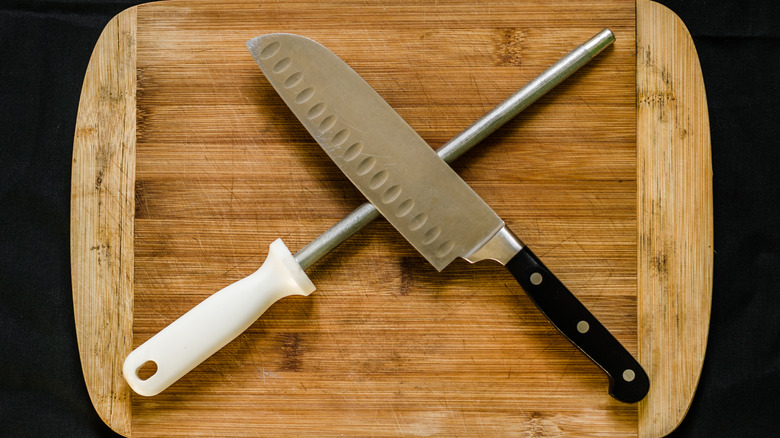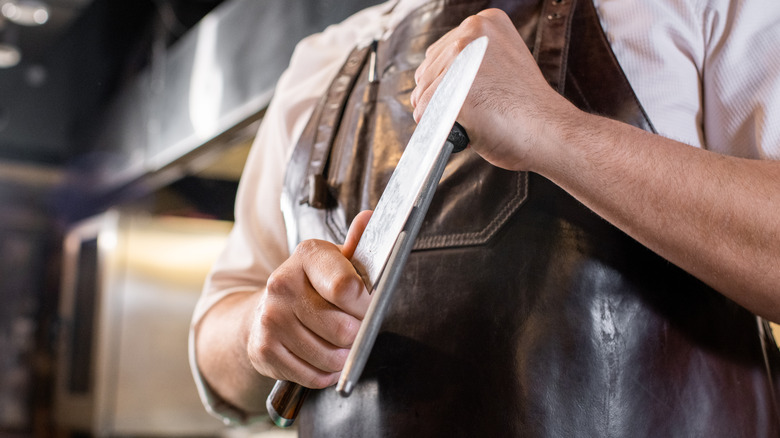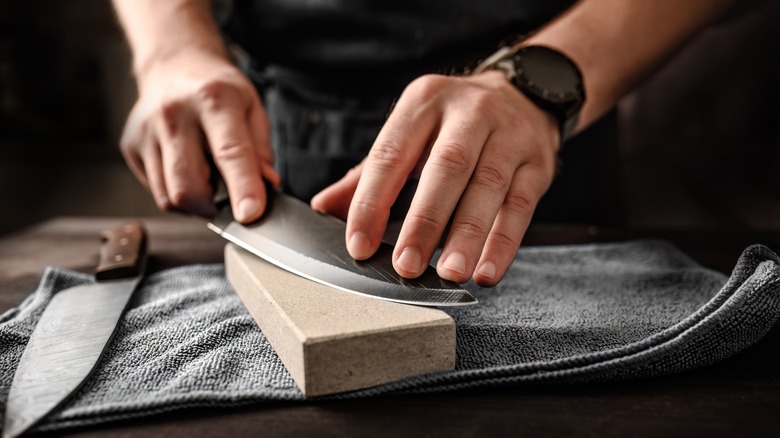Why You Should Rinse Your Knife Every Time You Hone It
Used to prepare nearly every dish, knives are the workhorses in the world of kitchen tools. But with each chop, slice, and dice, a knife blade wears down. Over time, blades become dull and struggle to slice tomatoes, much less julienne a tall stack of carrots. Besides being ineffective, dull knives are also dangerous. To keep your knives in top-tier shape and prevent your knife block from filling up with useless steel, you'll need to invest in some regular maintenance.
The primary preservation technique? Honing. Performed much more frequently than sharpening, honing maintains a knife's edge and ensures that it's ready to tackle any kitchen project. Breaking out the honing rod is a quick chore that's well worth the effort on a routine basis. While it will only take you a few minutes to properly hone a blade, it's equally important to thoroughly clean and rinse the knife before you put it to use. Washing the blade will ensure that no harmful metal debris ends up in your next meal.
What is honing?
So, what exactly is honing? According to knife manufacturer Wusthof, honing "realigns the microscopic teeth on the edge of the blade," maintaining the sharpness that can swiftly slice a tomato or dice an onion. Hone your knife by running it across the side of a thin cylinder called a honing steel. Draw the blade across the steel surface while trying to maintain the same angle already cut into the edge of the blade. This process will repair the normal wear and tear on your knife that comes from frequent use.
After honing, don't forget to rinse the blade with soap and water. This is an incredibly important step before you use that fresh blade to chop up dinner. The honing process can dislodge small pieces of steel from the blade edge, which can then remain stuck to the knife. You definitely want to prevent those from landing on your cutting board or finding their way into your next mirepoix. A simple rinse will suffice, but always rinse by hand and avoid putting your knife in the dishwasher.
Knives should be honed regularly — even daily. If you're not in the habit of caring for your knives, that might seem like a lot. But, it's a quick process that can easily be added to your nightly cooking routine.
What about sharpening?
Besides honing, you've probably also heard of sharpening. While the two may sound similar, honing and sharpening are very different processes. According to Wusthof, sharpening "takes a small amount of steel off the blade, creating a new edge." Sharpening frequency depends on the blade metal, along with how often it's used and honed. Stainless steel blades are softer than carbon steel blades and typically need to be sharpened more often. Blades should be sharpened when they no longer hold the edge from their regular honing.
Knives are commonly sharpened against a whetstone. Stones come in a variety of materials and grits designed for different blades. A basic water stone works well as an all-around sharpening tool for straight blades. A diamond stone is required to effectively sharpen harder metals. As an alternative to whetstones, electric sharpeners can sharpen multiple types of blades and have pre-set angle options for easy use.
To maintain a sharp knife, you need to store it properly. Proper storage will slow the dulling process and help keep your knives in top-notch shape. After rinsing, make sure to quickly dry all knives to prevent rust from forming on the blade. Once dry, don't just throw knives into drawers or cupboards; instead, invest in a quality knife block or a magnetic hanging strip. If you don't own either, you can always wrap your knives in newspaper, which will protect the edges and keep the metal slightly oiled, preventing rust.


